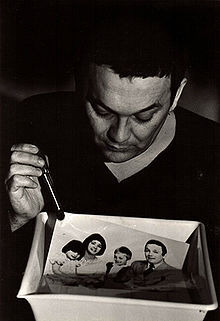Photo lab

- For commercial minilabs or large photographic laboratories, see Photofinishing .
In a photographic laboratory , depending on the facility (hobby laboratory, photographer's laboratory, rapid laboratory , photocopier or professional specialist laboratory) and equipment (amateur, manual or industrial), films can be developed and contact copies and enlargements or film copies made. The laboratory itself or a part or a machine of it is usually a light-tight darkroom , because the extremely light-sensitive material has to be processed in the dark or with suitable lighting (see below).
activities
The development of films and papers , in color and black and white, can be done manually ( can or tray ) or in machines . Reproductions, duplicates and microfilms as well as special recordings can be created. Image retouching, image montage and image refinement are added to the photographic laboratory work.
During development, the latent image (exposed light-sensitive emulsion ) is amplified into a visible image by a chemical process . The temperature , the composition of the chemicals and the duration of the treatment have a major influence on the result .
Film or photo paper is exposed ; the exposure can be done digitally or directly ( photogram ) with the camera , with the enlarger , with an exposure device.
Surroundings
In a photo laboratory it has to be dark in order not to render light-sensitive material such as film or photo paper unusable. The much less sensitive photo paper is not equally sensitive to the entire spectrum of visible light. Laboratory lighting can therefore be used with light in wavelengths to which the paper used is insensitive.
Each type of paper requires its own light color for laboratory lighting. Color paper is mostly insensitive to yellow-green light, black and white paper to red or amber light.
Light-emitting diodes , sodium vapor lamps or weak incandescent lamps (usually 15 watts) with colored filters are used as light sources .
